|
Origin
of Case
On the evening
of Monday, June 22, 1953, a delivery boy for the "Brooklyn Eagle" knocked
on the door of one of his customers in the apartment building at 3403 Foster
Avenue in Brooklyn. It was "collecting time" again. A lady answered the
door. She disappeared for a moment, then returned with a purse in her hand.
"Sorry, Jimmy,"
she said. "I don't have any change. Can you break this dollar bill for
me?"
The newsboy
quickly counted the coins in his pocket. There were not enough. "I'll ask
the people across the hall," he said.
There were two
ladies in the apartment across from the one occupied by Jimmy's customer.
By pooling the coins in their pocketbooks, they were able to give the newsboy
change for a dollar.
After he collected
for the newspaper, Jimmy left the apartment house jingling several coins
in his left hand. One of the coins seemed to have a peculiar ring. The
newsboy rested this coin, a nickel, on the middle finger of his hand. It
felt lighter than an ordinary nickel.
He dropped this
coin to the floor. It fell apart! Inside was a tiny photograph -- apparently
a picture of a series of numbers.
Two days later
(Wednesday, June 24, 1953) during a discussion of another investigation,
a detective of the New York City Police Department told a Federal Bureau
of Investigation (FBI) Agent about the strange hollow nickel which, he
had heard, was discovered by a Brooklyn youth. The detective had received
his information from another police officer whose daughter was acquainted
with the newsboy.
When the New
York detective contacted him, Jimmy handed over the hollow nickel and the
photograph it contained. The detective, in turn, gave the coin to the FBI.
In examining
the nickel, Agents of the FBI's New York Office noted that the microphotograph
appeared to portray nothing more then ten columns of typewritten numbers.
There was five digits in each number and 21 numbers in most columns. The
Agents immediately suspected that they had found a coded espionage message.
They carefully wrapped the nickel and microphotograph for shipment to the
FBI Laboratory.
Upon its receipt
in Washington on June 26, 1953, the nickel was subjected to the thorough
scrutiny of a team of FBI scientific experts. Hollow coins, though rarely
seen by the ordinary citizen, are occasionally used in magic acts and come
to the attention of Federal law enforcement agencies from time to time.
This was the first time, however, that the FBI had ever encountered a nickel
quite like this one.
The face of
the coin was a 1948 Jefferson nickel. In the "R" of the word "TRUST", there
was a tiny hole -- obviously drilled there so that a fine needle or other
small instrument could be inserted to force the nickel open.
The reverse
side had been made from another nickel -- one minted sometime during the
period of 1942 to 1945. It was composed of copper-silver alloy, there being
a shortage of nickel during World War II.
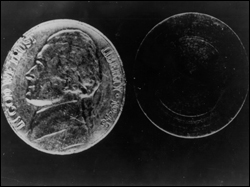 |
|
Hollow nickel
|
While efforts
were being made to decode the message on the microphotograph, FBI Agents
in New York launched an investigation to find the source of the hollow
coin. The two ladies who had changed the newboy's dollar on the evening
of June 22 were located. Yes, they remembered Jimmy; but, if either had
given him a hollow nickel, it was entirely unintentional. "Why, we've never
seen a hollow coin -- or, for that matter, even heard of one before."
The proprietors
of novelty stores and related business establishments in the New York vicinity
were contacted. Photographs of the hollow coin were shown to them. None
could recall seeing a nickel or other coin quite like this one.
"It's not suitable
for a magic trick," one novelty salesman commented. "The hollowed-out area
is too small to hide anything aside from a tiny piece of paper.
In Washington,
each effort to decipher the microphotograph met with failure. Additionally,
the kind of typewriter which had been used in preparing the coded message
could not be identified. Since the FBI Laboratory maintains a reference
file concerning typewriters manufactured in the United States, a foreign-made
typewriter undoubtedly was involved.
From 1953 to
1957, continuing efforts were made to solve the mystery of the hollow coin.
Several former intelligence agents who had defected to the free world from
communist-bloc nations were contacted. They could shed no light on the
case.
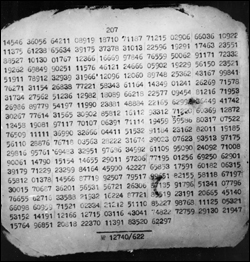 |
|
Hollow nickel message
|
As the search
for the source of the hollow nickel expanded across the United States,
hollow subway tokens, "trick" coins, and similar objects were submitted
to the FBI Laboratory by Agents in various parts of the country. From New
York came a half dollar which had been ground in such a manner that smaller
coins could be concealed under it. From Los Angeles came a peculiar-looking
1953 Lincoln penny. FBI scientists determined that it had been coated with
nickel.
Two hollow pennies
were found in Washington, D.C. Neither of these pennies, nor the assortment
of other coins which the Laboratory examined, was found to have tool markings
or other distinguishing features to identify it with the newsboy's 1948
Jefferson nickel.
In the intelligence
and counterintelligence field, patience is more than a virtue. It is an
absolute necessity. Months of determined probing by the FBI's scientists
and investigative staff had led merely to one blind alley after another.
Yet, the relentless search to identify the person who had brought the hollow
nickel to New York, as well as the person for whom the coded message was
intended, continued.
Defection
of a Russian Spy
The key to this
mystery proved to be a 36-year-old Lieutenant Colonel of the Soviet State
Security Service (KGB). Early in May, 1957, he telephoned the United States
Embassy in Paris and subsequently arrived at the Embassy to be interviewed.
To an Embassy official, the Russian espionage agent explained, "I'm an
officer in the Soviet intelligence service. For the past five years, I
have been operating in the United States. Now I need your help."
This spy, Reino
Hayhanen, stated that he had just been ordered to return to Moscow. After
five years in the United States, he dreaded the thought of going back to
his communist-ruled homeland. He wanted to defect -- to desert the Soviet
camp.
Hayhanen was
born near Leningrad on May 14, 1920. His parents were peasants. Despite
his modest background, Hayhanen was an honor student and, in 1939, obtained
the equivalent of a certificate to teach high school.
In September,
1939, Hayhanen was appointed to the primary school faculty in the Village
of Lipitzi. Two months later, however, he was conscripted by the Communists'
secret police, the NKVD. Since he had studied the Finnish language and
was very proficient in its use, Hayhanen was assigned as an interpreter
to an NKVD group and sent to the combat zone to translate captured documents
and interrogate prisoners during the Finnish-Soviet war.
With the end
of this war in 1940, Hayhanen was assigned to check the loyalty and reliability
of Soviet workers in Finland and to develop informants and sources of information
in their midst. His primary objective was to identify anti-Soviet elements
among the intelligentsia.
Hayhanen became
a respected expert in Finnish intelligence matters and in May, 1943, was
accepted into membership in the Soviet Communist Party. Following World
War II, he rose to the rank of senior operative authorized representative
of the Segozerski district section of the NKGB and, with headquarters in
the Village of Padani, set about the task of identifying dissident elements
among the local citizens.
In the summer
of 1948, Hayhanen was called to Moscow by the KGB. The Soviet intelligence
service had a new assignment for Hayhanen -- one which would require him
to sever relations with his family, to study the English language, and
to receive special training in photographing documents, as well as to encode
and decode messages.
While his KGB
training continued, Hayhanen worked as a mechanic in the City of Valga,
Estonia. Then, in the summer of 1949, he entered Finland as Eugene Nicolai
Maki, an American-born laborer.
Background
of the Real Maki
The real Eugene
Nicolai Maki was born in Enaville, Idaho, on May 30, 1919. His mother also
was American born, but his father had immigrated to the United States from
Finland in 1905. In the mid-1920s, Eugene Maki's parents became deeply
impressed by glowing reports of conditions in "the new" Russia. They sold
their belongings and left their Idaho farm for New York to book passage
on a ship to Europe.
After leaving
the United States, the Maki family settled in Estonia. From the outset,
it was obvious that they had found no "Utopia" on the border of the Soviet
Union. Letters which they wrote to their former neighbors showed that Mr.
and Mrs. Maki were very unhappy and sorely missed America.
As the years
passed, memories of the Maki family gradually began to fade, and all but
possibly two or three old time residents of Enaville, Idaho, forgot that
there has ever been a Maki family in that area. In Moscow, however, plans
were being made for a "new" Eugene Maki, one thoroughly grounded in Soviet
intelligence techniques, to enter the scene.
Hayhanen
Becomes Maki
From July, 1949,
to October, 1952, Hayhanen resided in Finland and established his identity
as the American-born Eugene Maki. During this period, he was most cautious
to avoid suspicion or attracting attention to himself -- his Soviet superiors
wanting him to become established as an ordinary, hard-working citizen.
This false "build up," of course, was merely part of Hayhanen's preparation
for a new espionage assignment.
While in Finland,
Hayhanen met and married Hanna Kurikka. She was to join him in the United
States on February 20, 1953 -- four months after his arrival here. Even
his wife knew him only as Eugene Maki, so carefully did he cover his previous
life.
On July 3, 1951,
Hayhanen -- then living in Turku, Finland -- visited the United States
Legation in Helsinki. He displayed a birth certificate from the State of
Idaho which showed that he was born in Enaville on May 30, 1919, and, in
the presence of a Vice Consul, he executed an affidavit in which he explained
that his family had left the United States in 1928:
| "I accompanied my mother to Estonia when I was eight years of age
and resided with her until her death in 1941. I left Estonia for Finland
in June, 1943, and have resided here for the reason that I have no funds
with which to pay my transportation to the United States." |
One year later
-- July 28, 1952 -- a passport was issued to Hayhanen as Eugene Maki at
Helsinki. Using this passport, he sailed October 16, 1952, from Southhampton,
England, aboard the Queen Mary and arrived at New York City on October
21, 1952.
Several weeks
before he departed for America, Hayhanen was recalled to Moscow and introduced
to a Soviet agent, "Mikhail," who was to serve as his espionage superior
in this country. In order to establish contact with "Mikhail" in the United
States, Hayhanen was instructed that after arriving in New York he should
go to the Tavern on the Green in Central Park. Near the tavern, he was
told, he would find a signpost marked "Horse Carts"
"You will let
Mikhail know of your arrival by placing a red thumb tack in this signpost,"
a Soviet official told him. "If you suspect that you are under surveillance,
place a white thumb tack on the board."
Hayhanen
Returns to the United States
The information
which Hayhanen furnished to U.S. officials in Paris, France, in May, 1957,
was immediately checked. There could be no question of its accuracy. Accordingly,
passage was secured for Hayhanen on an airliner, and he was permitted to
return to the United States.
Following his
arrival in New York on May 10, 1957, Hayhanen was given a thorough physical
examination, suitable quarters were found for him, and arrangements were
made for him to be interviewed by FBI Agents.
From the fall
of 1952 until early in 1954, he said, "Mikhail" served as his espionage
superior in New York. They met only when necessary -- the meeting place
being the Prospect Park subway station. To exchange messages and intelligence
data, they used "dead drops" -- inconspicuous hiding places -- in the New
York area. One of these "dead drops" was an iron picket fence at the end
of 7th Avenue near Macombs bridge. Another was the base of a lamp post
in Fort Tryon Park.
In one of the
"dead drops" mentioned by Hayhanen -- a hole in a set of cement steps in
Prospect Park -- FBI Agents found a hollowed-out bolt. The bolt was about
two inches long and one-fourth inch in diameter. It contained the following
typewritten message:
| "Nobody came to meeting either 8 or 9th...as I was advised he should.
Why? Should he be inside or outside? Is time wrong? Place seems right.
Please check." |
 |
|
Hollowed-out
bolt
|
The bolt was
found on May 15, 1957. It had been placed in the "dead drop" about two
years previously, but, by a trick of fate, a repair crew had filled the
hole in the stairs with cement, entombing the bolt and the message it contained.
 |
|
Hollowed-out
bolt opened
|
Questioned about
the hollow bolt, Hayhanen said that "trick" containers such as this were
often used by the espionage apparatus which he served. Among the items
he had been supplied by the Soviets were hollow pens, pencils, screws,
batteries, and coins -- in some instances magnetized so they would adhere
to metal objects.
Hollow 50
Markkaa Coin
In the modest
home of Hayhanen and his wife on Dorislee Drive in Peekskill, New York,
FBI Agents found such items as a 50 Markka coin from Finland. It had been
hollowed out, and there was a small hole in the first "a" of the word "Tasavalta"
which appeared on the "tail side" of this coin.
FBI Laboratory
experts examined this Finnish coin on May 17, 1957. They immediately noted
that it bore a great similarity to the Jefferson nickel which the Brooklyn
newsboy had discovered in 1953. Two separate coins obviously had been used
in making this "trick" 50 Markkaa piece. This also was the case with the
hollow nickel. And both coins had a small hole in one printed letter so
that a sharp-pointed instrument, such as a needle, could be used to open
them.
Although the
FBI was convinced that it had finally identified the Soviet espionage apparatus
which was responsible for the hollow Jefferson nickel, only one half of
the mystery posed by this coin since its discovery in June, 1953, had been
solved. The coded message which the nickel contained still had to be deciphered.
During the FBI's
extensive interviews with him, in May, 1957, Hayhanen was carefully questioned
regarding the codes and cryptosystems which he had used in the various
Soviet intelligence agencies he had served since 1939. The information
which he provided was applied by FBI Laboratory experts to the microphotograph
from the Jefferson nickel.
With this data,
the FBI Laboratory succeeded in breaking through the curtain of mystery
which surrounded the coded message. By June 3, 1957, the full text of the
microphotograph was known. The message apparently was intended for Hayhanen
and had been sent from the Soviet Union shortly after his arrival in the
United States. It read:
| "1. WE CONGRATULATE YOU ON A SAFE ARRIVAL. WE CONFIRM
THE RECEIPT OF YOUR LETTER TO THE ADDRESS `V REPEAT V' AND THE READING
OF LETTER NUMBER 1." |
| "2. FOR ORGANIZATION OF COVER, WE GAVE INSTRUCTIONS TO
TRANSMIT TO YOU THREE THOUSAND IN LOCAL (CURRENCY). CONSULT WITH US PRIOR
TO INVESTING IT IN ANY KIND OF BUSINESS, ADVISING THE CHARACTER OF THIS
BUSINESS." |
| "3. ACCORDING TO YOUR REQUEST, WE WILL TRANSMIT THE FORMULA
FOR THE PREPARATION OF SOFT FILM AND NEWS SEPARATELY, TOGETHER WITH (YOUR)
MOTHER'S LETTER." |
| "4. IT IS TOO EARLY TO SEND YOU THE GAMMAS. ENCIPHER
SHORT LETTERS, BUT THE LONGER ONES MAKE WITH INSERTIONS. ALL THE DATA ABOUT
YOURSELF, PLACE OF WORK, ADDRESS, ETC., MUST NOT BE TRANSMITTED IN ONE
CIPHER MESSAGE. TRANSMIT INSERTIONS SEPARATELY." |
| "5. THE PACKAGE WAS DELIVERED TO YOUR WIFE
PERSONALLY. EVERYTHING IS ALL RIGHT WITH THE FAMILY. WE WISH YOU SUCCESS.
GREETINGS FROM THE COMRADES. NUMBER 1, 3RD OF DECEMBER." |
Other Soviet
Agents
Although Hayhanen
assisted the FBI in solving the mystery of the hollow nickel, the information
he furnished placed other critical challenges before the Agents. "Mikhail,"
the Soviet with whom Hayhanen maintained contact from the fall of 1952
until early 1954, was yet to be identified. And, when "Mikhail" dropped
from the scene in 1954, Hayhanen was turned over to another Russian spy,
one known only as "Mark". Hayhanen felt that "Mark" undoubtedly was still
actively engaged in espionage within the United States! He also must be
identified.
Hayhanen obtained
the impression that "Mikhail" was a Soviet diplomatic official -- possibly
attached to the Embassy or the United Nations. He described "Mikhail" as
probably between 40 and 50 years old; medium build; long, thin nose; dark
hair; and about five feet nine inches tall. This description was matched
against the descriptions of Soviet representatives who had been in the
United States between 1952 and 1954. From the long list of possible suspects,
the most logical "candidate" appeared to be Mikhail Nikolaevich Svirin.
Svirin had been
in and out of the United States on several occasions between 1939 and 1956.
From the latter part of August, 1952, until April, 1954, he had served
as the First Secretary to the Soviet United Nations Delegation in New York.
On May 16, 1957,
FBI Agents showed a group of photographs to Hayhanen. The moment his eyes
fell upon a picture of Mikhail Nikolaevich Svirin, Hayhanen straightened
up in his chair and announced, "That's the one. There is absolutely no
doubt about it. That's Mikhail.'"
Svirin was beyond
reach of American justice. He had returned to the Soviet Union in October,
1956.
The FBI's next
task was to identify "Mark," the Soviet agent who had succeeded "Mikhail"
as Hayhanen's contact man. Hayhanen did not know where "Mark" was residing
or the name which "Mark" was using; however, he was able to furnish many
other details concerning him.
According to
Hayhanen, "Mark" was a colonel in the KGB and had been engaged in espionage
work since approximately 1927. He had come to the United States in 1948
or 1949, entering by illegally crossing the Canadian border.
In keeping with
instructions contained in a message he received from Soviet officials,
Hayhanen was met by "Mark" at a movie theater in Flushing, Long Island,
during the late summer of 1954. As identification symbols, Hayhanen wore
a blue and red striped tie and smoked a pipe.
After their
"introduction" at this theater, Hayhanen and "Mark" held frequent meetings
in Prospect Park, on crowded streets, and in other inconspicuous places
in the area of Greater New York. They also made several short trips together
to Atlantic City, Philadelphia, Albany, Greenwich, and other communities
in the eastern part of the United States.
"Mark" also
sent Hayhanen on trips alone. For example, in 1954, "Mark" instructed him
to locate an American Army sergeant, one formerly assigned to the United
States Embassy in Moscow. At the time he related this information to FBI
Agents in May, 1957, Hayhanen could not remember the Army sergeant's name.
"I do recall, however, that we used the code name `Quebec' in referring
to him and that he was recruited for Soviet intelligence work while in
Moscow."
(An intensive
investigation was launched to identify and locate "Quebec." It quickly
produced results when, in examining a hollow piece of steel from Hayhanen's
home, the FBI Laboratory discovered a piece of microfilm less than one-inch
square. The microfilm bore a typewritten message which identified "Quebec"
as Army sergeant Roy Rhodes and stated the Soviet agents had recruited
him in January, 1952. Full information concerning Rhodes' involvement in
Russian espionage was disseminated to the Army; and following a court-martial,
he was sentenced to serve five years at hard labor.)
Hayhanen described
"Mark" as about 50 years old or possibly older; approximately five feet
ten inches tall; thin gray hair; and medium build. The unidentified Soviet
agent was an accomplished photographer, and Hayhanen recalled that on one
occasion in 1955, "Mark" took him to a storage room where he kept photo
supplies on the fourth or fifth floor of a building located near Clark
and Fulton Streets in Brooklyn.
The search for
this storage room led FBI Agents to a building at 252 Fulton Street. Among
the tenants was one Emil R. Goldfus, a photographer who had operated a
studio on the fifth floor since January, 1954 -- and who also had formerly
rented a fifth-floor storage room there.
In April, 1957
(the same month Hayhanen boarded a ship for Europe under instructions to
return to Moscow), Goldfus had told a few persons in the Fulton Street
building that he was going South on a seven-week vacation. "It's doctor's
orders," he explained. "I have a sinus condition."
Goldfus disappeared
about April 26, 1957. Less than three weeks later, FBI Agents arrived at
252 Fulton Street in pursuit of the mysterious "Mark." Since Goldfus appeared
to answer the description of Hayhanen's espionage superior, surveillance
was established near his photo studio.
On May 28, 1957,
Agents observed a man resembling "Mark" on a bench in a park directly opposite
the entrance to 252 Fulton Street. This man occasionally walked about the
park; he appeared to be nervous; and he created the impression that he
was looking for someone -- possibly attempting to determine any unusual
activity in the neighborhood. At 6:50 p.m., this man departed on foot --
the Agents, certain their presence had not been detected, chose to wait
rather than take a chance of trailing the wrong man. "If that's `Mark,'
he'll return," they correctly surmised.
While the surveillance
continued at 252 Fulton Street, other FBI Agents made daily checks on the
"dead drops" which Hayhanen stated he and "Mark" had used. The Agents'
long hours of patience were rewarded on the night of June 13, 1957. At
10:00 p.m., they saw the lights go on in Goldfus' studio, and a man was
observed moving in the room.
The lights went
out at 11:52 p.m., and a man who appeared to generally fit the description
of "Mark" stepped into the darkness outside the building. This man was
followed down Fulton Street to a nearby subway station. Moments later,
FBI Agents saw him take a subway to 28th Street, and they stood by unnoticed
as he emerged from the subway and walked to the Hotel Latham on East 28th
Street.
On June 15,
a photograph of Goldgus which the FBI took with a hidden camera was shown
to Hayhanen. "You've found him," the former Soviet Agent exclaimed. "That's
`Mark.'"
Goldfus -- registered
at the Hotel Latham under the name of Martin Collins -- was kept under
surveillance from the night of June 13 until the morning of June 21, 1957.
During this period, FBI Agents discreetly tied together the loose ends
of the investigation, matters which had to be resolved before this Russian
intelligence officer could be taken into custody.
Arrested by
the Immigration and Naturalization Service on an alien warrant based upon
his illegal entry into the United States and failure to register as an
alien, "Mark" displayed a defiant attitude. He refused to cooperate at
all.
Following his
arrest, "Mark" was found to possess many false papers, including two American
birth certificates. The first showed that he was Emil R. Goldfus, born
August 2, 1902, in New York City. According to the second one, he was Martin
Collins, born June 2, 1897, also in New York. Investigation was to establish
that the Emil Goldfus whose birth certificate "Mark" displayed had died
in infancy. The certificate in the name of Collins was a forgery.
During his career
as a soviet spy, "Mark" also had used many other nabel in addition to the
ones cited above. For example, during the fall of 1948, while en route
to the United States from the Soviet Union, he had adopted the identity
of Andrew Kayotis. The real Andrew Kayotis, believed to have died in a
Lithuanian hospital, was born in Lithuania on October 10, 1895. He had
arrived in the United States in October, 1916, and became a naturalized
American citizen at Grand Rapids, Michigan, on December 30, 1930.
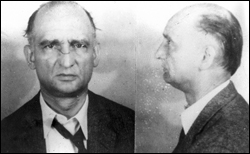 |
|
Rudolf
Ivanovich Abel
|
On July 15,
1947, Andrew Kayotis, then residing in Detroit, was issued a passport so
that he could visit relatives in Europe. Investigation in Detroit disclosed
that several persons there considered Kayotis to be in poor physical condition
at the time of his departure from the United States. Letters subsequently
received from him indicated that he was in a Lithuanian hospital. When
Kayotis' friends in Michigan heard no more from him, they assumed that
he had passed away.
Nearly 10 years
later, "Mark" was to admit that he had used Kayotis' passport during the
fall of 1948 in booking passage aboard an ocean liner from LeHavre, France,
to Canada. On November 14, 1948, he disembarked from the ship at Quebec
-- and quickly dropped out of sight.
"Mark" made
another admission -- that he was a Russian citizen, Rudolf Ivanovich Abel,
born July 2, 1902, in the Soviet Union. Although he refused to discuss
his intelligence activities, the photo studio and hotel room which he occupied
were virtual museums of modern espionage equipment. They contained shortwave
radios, cipher pads, cameras and film for producing microdots, a hollow
shaving brush, cuff links, and numerous other "trick" containers.
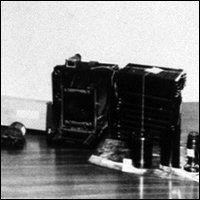 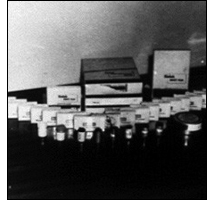
Camera and
Photographic Equipment found at Network Headquarters, Brooklyn, N.Y. used
for preparation of microfilm messages.
|
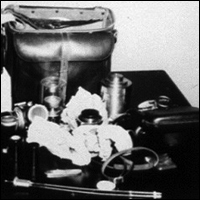 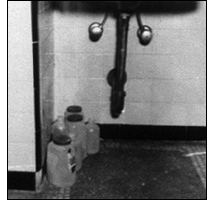
Camera and
Equipment in "Mark's" possession at time of arrest used for preparation
of messages for Moscow.
|
Indicted as
a Russian spy, Colonel Abel was tried in Federal court at New York City
during October, 1957. Among the government witnesses to testify against
him was his former trusted espionage assistant, Lieutenant Colonel Reino
Hayhanen.
On October 25,
1957, the jury announced its verdict -- Abel was guilty of all counts.
He appeared before Judge Mortimer W. Byers on November 15, 1957, and was
sentenced as follows (the three sentences to be served concurrently):
-
Count One (Conspiracy to transmit defense information to the Soviet
Union), 30 years' imprisonment.
-
Count Two (Conspiracy to obtain defense information), 10 years' imprisonment
and $2,000 fine.
-
Count Three (Conspiracy to act in the United States as an agent of a
foreign government without notification to the Secretary of State), 5 years'
imprisonment and $1,000 fine.
|
Colonel Abel
appealed his convictions, claiming that rights guaranteed to him under
the Constitution and laws of the United States had been violated. By a
five-to-four decision which was handed down on March 28, 1960, the Supreme
Court upheld the conviction of this Russian spy.An investigation which
had started with a newsboy's hollow nickel ultimately resulted in the smashing
of a Soviet spy ring. On February 10, 1962, Rudolf Invanovich Abel was
exchanged for the American U-2 pilot, Francis Gary Powers, who was a prisoner
of the Soviet Union.
|
